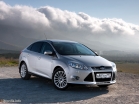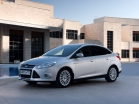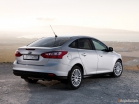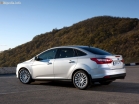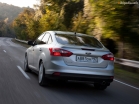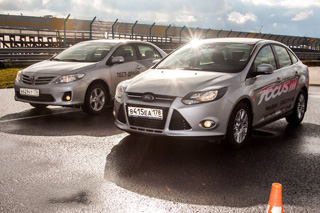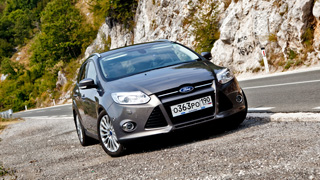Test Drive Ford Focus Sedan since 2010 Sedan
Triumph Zhada
Talking about the new Diesel Ford Focus, replenishing the editorial park (SM, 2006, No. 9), I mentioned: if you roll at a speed of 7080 km / h, you can go to Peter on one tank!. It was called Gruzny Fly behind the wheel.We drove to Ford Focus on the route Moscow St. Petersburg - Moscow with an average expenditure of diesel fuel 3.72 liters per 100 km.
Case Principle
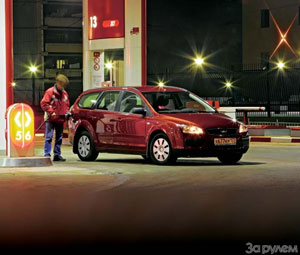 Of course, a canister with a diesel fuel in the trunk lasted. And even specified in advance: the production of tank dry, although it is not useful for Ford Focus, but not fatal for fuel equipment and does not require tricks with the subsequent start of the engine.
Of course, a canister with a diesel fuel in the trunk lasted. And even specified in advance: the production of tank dry, although it is not useful for Ford Focus, but not fatal for fuel equipment and does not require tricks with the subsequent start of the engine. The idea naturally arose not in an empty place. Trial measurements have shown: at a speed of 80 km / h, the car consumes about 3.8 l / 100 km, that is, the mileage of the MoscowPatermocaw on one tank is theoretically executed. In general, less than 4 l / 100 km is not such an achievement. When conducting an ecorally, such results sought on almost standard VAZ 2110. But what price? Packed tires, disconnected electricity consumers, overtaking with a minimum difference in speed, overclocking mode, slipping by trucks, violations of traffic rules All these risky, and sometimes simply scaling techniques decisively rejected. Follow the simplest rules:
1. Tire pressure is no longer allowed at full load.
2. The headlights are always included, including in settlements.
3. If the length of the site does not allow to complete the overtaking safely and without violation of traffic rules, savings goes to the background.
4. The overclocking mode is excluded due to the interference created by other participants of the movement.
5. Adhere to the bount of the truck to reduce the resistance of the air, too, it is also impossible. Moreover, this reception is fraught with an obstacle missed by a truck between the wheels, and the danger of getting a stone in the forehead.
What will I save on? I will try to optimally choose the mode of movement, turn off the engine at stops and traffic lights, limit the use of powerful power consumers (heated seats, rear windows, loud music) and, of course, air conditioning. Well, a little, I will play a little on the place and time of start and finish.
 Start in Khimki at LUKOIL refueling (3 km from the Moscow Ring Road), turning the Victory Square in St. Petersburg, the finish on the consolidation of fuel or in a convenient location on the Leningrad highway. The optimal start time, of course, I choose the early morning of 4:30. There will be no dense stream, especially traffic jams in the suburbs. In Peter, arrive in the middle of the day when there is a relative lull on the streets. The reverse route after the night is a bit more busy: departure at noon, to be in the capital is not too early. By the way, we returned to Moscow on Friday, the flow of trucks there at this time is minimal.
Start in Khimki at LUKOIL refueling (3 km from the Moscow Ring Road), turning the Victory Square in St. Petersburg, the finish on the consolidation of fuel or in a convenient location on the Leningrad highway. The optimal start time, of course, I choose the early morning of 4:30. There will be no dense stream, especially traffic jams in the suburbs. In Peter, arrive in the middle of the day when there is a relative lull on the streets. The reverse route after the night is a bit more busy: departure at noon, to be in the capital is not too early. By the way, we returned to Moscow on Friday, the flow of trucks there at this time is minimal. On the droplet
You go quiet more traveling accounting folklore sometimes no worse than the driver. The formula for optimal movement in mathematical terms is approximately such: the less the difference between the average and maximum speed, the better. The optimal average speed is 70 km / h. Then the distance in one direction can be passed in 10 hours and to meet approximately 3.8 l / 100 km. The strategy is clearly choosing tactics.
The capacity of the fuel tank is the concept of unseasonable. According to the instructions 53 liters. But if you rely on the cut-off of the refueling pistol, but on a neat manual refueling, it is placed almost 1.5 l to the tank, under the edge of the neck and if used it was possible to refuel the chilled fuel!
 The density of petroleum products is quite highly dependent on the temperature, and in the same tank can be shoved by 45% no longer in volume, but by weight. This trick, by the way, in the course of aviator, setting range records. But we have no such opportunity, and desire too. We are honest!
The density of petroleum products is quite highly dependent on the temperature, and in the same tank can be shoved by 45% no longer in volume, but by weight. This trick, by the way, in the course of aviator, setting range records. But we have no such opportunity, and desire too. We are honest! The GPS receiver introduces the reversal point coordinates. On the clock 4:35. Run the engine and go ahead! After 36 minutes we pass Solnechnogorsk. On the on-board computer, the average consumption was stabilized at a mark of 3.7 l / 100 km, the average speed is 63.4 km / h. Mode: Fifth gear, 1550 rpm, 80 km / h on speedometer, 77 km / h in GPS. Braking in front of the transmission traffic, in this mode, fuel is not served. And with a complete stop, turn off the motor.
No hour passed, behind the wedge. Because of it, the average speed stopped at 63.2 km / h. Another hour of the road, and after the bypass road around Tver, speed rises to 64.3 km / h. Fuel consumption is unchanged. About three hours after the start, the average speed goes to 67 km / h. When halfway remains behind, the arrow of the fueluver, as if playing by us, shows more than three quarters of the tank. We are on the way for 5 hours 26 minutes. The desert road, like a wallet day before salary. The on-board computer is going with thoughts and changes the readings of the average consumption is now 3.6 l / 100 km. I add a little: on speedometer 85 km / h. The average is tangible grows already 68.7 km / h. The planned 70 remains quite a bit. Mission Possible!
 Under the Tosno Grand Cork: Road Repair Plus a couple of minor accidents. All record indicators are melted in their eyes. In half an hour, the movement seems to be normalized, but at the entrance to St. Petersburg gets up again. St. Petersburg traffic jams are not so tough as Moscow, but this is not easier to make all the savings.
Under the Tosno Grand Cork: Road Repair Plus a couple of minor accidents. All record indicators are melted in their eyes. In half an hour, the movement seems to be normalized, but at the entrance to St. Petersburg gets up again. St. Petersburg traffic jams are not so tough as Moscow, but this is not easier to make all the savings. Finally, the long-awaited Victory Square! Circle of honor and posing for the photo. And the fuel is already less than Polbath, if you believe the pointer, and the time spent 11 hours, not 10. It's time to rest: it turns out that nothing tires as economical ride
IN ONE BREATH
At the departure from Peter, traffic jams, but not so tedious. Fuel consumption is again below 3.8 l / 100 km, and the average speed grows up to 68 km / h. It grieves that there is already a lot of less than half on the fuel age. Are you not going to do? The trip begins to seem interesting.
The small rain stops, and from the North-West we caught a passing breeze. It seems to be completely imperceptible, but 0.2 l / 100 km helps to save! Middle speed does not increase, 68.7 km / h is quite enough, but the stubborn on-board computer is adamant: the fuel will end somewhere in the wedge area. And if still near Moscow traffic jams? After lunch, the average consumption continues to hold 3.5 l / 100 km, but still obviously: not enough to Moscow. Yellow light bulb The fuel balance lights up to the wedge. So stand out somewhere in the Zelenograd area. Touching with this thought, I pull on. Soon after Solnechnogorsk, anxious inscription on the instrument combinations announces a stock along 0 km. If you believe this real consumption by 10% more than the computer shows. Really so?
 Zelenograd, Sheremetyevo, Khimki swim around the window, Khimki, MKAD, so we arrived !!!
Zelenograd, Sheremetyevo, Khimki swim around the window, Khimki, MKAD, so we arrived !!! Take a photographer home? Please! Another 20 km on the Holy Spirit. All refueling! How many? 1397 km, 52 liters. In the tank still liter of fuel! In supeconomic mode, it's fifty kilometers! Average consumption of 3.72 l / 100 km. In Peter and back on one tank? Not easily, but really!
How much is to pee
For the shipment of natural necessary, the road in Russia is not fined and do not take money. And how much does it cost? Stop by the smallest need about a couple of minutes. Still as much on a leisurely way and landing into the car, a minute to stop and subsequent overclocking. TOTAL 5 minutes. During this time, a patient and law-abiding driver will be ahead of you for seven kilometers. To catch up to the lost time and restore the average speed at least in an hour, it will be necessary to burn extra no less than liter of fuel (this is for diesel focus and allowed 90 km / h). And this is excaning overtaking, which will probably have to make a lot. For gasoline car, the flow will be noticeably more. It turns out, a 10-ruble paid toilet on a gas station is not only convenient, but also beneficial!
Diesel focus can ride without refueling day (!) And pass to 1500 km. Fuel economy contribute to speed limit and high motion uniformity.



Anatoly Fomin
A source: Journal "Behind the wheel"

